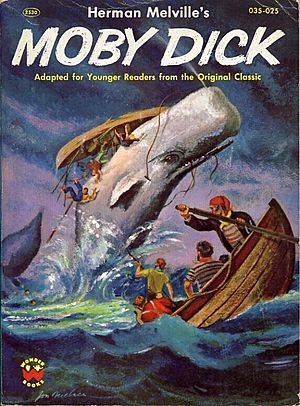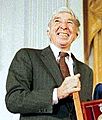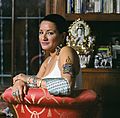American literature facts for kids
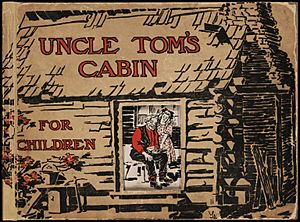
American literature is the literature written or produced in the area of the United States and its preceding colonies. Before the founding of the United States, the British colonies on the eastern coast of the present-day United States were heavily influenced by English literature. Thus, the American literary tradition began as part of the broader tradition of English literature. However, modern American literature is considered to be a separate literary tradition.
The New England colonies were the center of early American literature. The revolutionary period contained political writings by Samuel Adams, Benjamin Franklin and Thomas Paine. In the post-war period, Thomas Jefferson's United States Declaration of Independence solidified his status as a key American writer.
It was in the late 18th and early 19th centuries that the nation's first novels were published. With the War of 1812 and an increasing desire to produce uniquely American literature and culture, a number of key new literary figures emerged, perhaps most prominently Washington Irving and Edgar Allan Poe.
The political conflict surrounding abolitionism inspired the writings of William Lloyd Garrison and Harriet Beecher Stowe in her world-famous Uncle Tom's Cabin. These efforts were supported by the continuation of the slave narrative autobiography, of which the best known example from this period was Frederick Douglass's Narrative of the Life of Frederick Douglass, an American Slave.
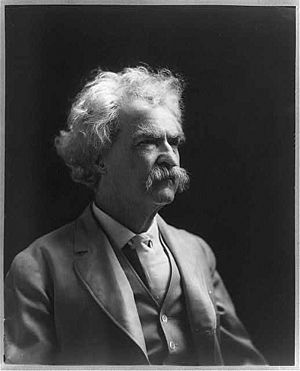
Herman Melville (1819–1891) is notable for his books Moby-Dick and Billy Budd. America's two greatest 19th-century poets were Walt Whitman (1819–1892) and Emily Dickinson (1830–1886). American poetry reached a peak in the early-to-mid-20th century, with such noted writers as Wallace Stevens, T. S. Eliot, Robert Frost, Ezra Pound, Hart Crane, and E. E. Cummings.
Mark Twain (the pen name used by Samuel Langhorne Clemens, 1835–1910) was the first major American writer to be born away from the East Coast. Henry James (1843–1916) was notable for novels like The Turn of the Screw.
At the beginning of the 20th century, American novelists included Edith Wharton (1862–1937), Stephen Crane (1871–1900), Theodore Dreiser (1871–1945), and Jack London (1876–1916). Experimentation in style and form is seen in the works of Gertrude Stein (1874–1946).
American writers expressed disillusionment following WW I. The stories and novels of F. Scott Fitzgerald (1896–1940) capture the mood of the 1920s, and John Dos Passos wrote about the war. Ernest Hemingway (1899–1961) became notable for The Sun Also Rises and A Farewell to Arms; in 1954, he won the Nobel Prize in Literature.
William Faulkner (1897–1962) is notable for novels like The Sound and the Fury. American drama attained international status only in the 1920s and 1930s, with the works of Eugene O'Neill, who won four Pulitzer Prizes and the Nobel Prize. In the middle of the 20th century, American drama was dominated by the work of playwrights Tennessee Williams and Arthur Miller, as well as by the growth of the American musical.
Depression era writers included John Steinbeck (1902–1968), notable for his novel The Grapes of Wrath. From the end of World War II until around the late 1960s and early 1970s, many popular works in modern American literature were produced, like Harper Lee's To Kill a Mockingbird. John Updike was notable for his novel Rabbit, Run (1960). Philip Roth explores Jewish identity in American society.
The main literary movement since the 1970s has been postmodernism, and since the late 20th century ethnic and minority literature has sharply increased.
Nobel Prize in Literature winners (American authors)
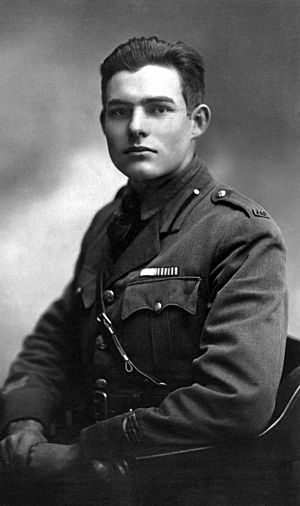
- 1930: Sinclair Lewis (novelist)
- 1936: Eugene O'Neill (playwright)
- 1938: Pearl S. Buck (biographer and novelist)
- 1948: T. S. Eliot (poet and playwright)
- 1949: William Faulkner (novelist)
- 1954: Ernest Hemingway (novelist)
- 1962: John Steinbeck (novelist)
- 1976: Saul Bellow (novelist)
- 1978: Isaac Bashevis Singer (novelist, wrote in Yiddish)
- 1987: Joseph Brodsky (poet and essayist, wrote in English and Russian)
- 1993: Toni Morrison (novelist)
- 2016: Bob Dylan (songwriter)
Images for kids
-
Main reading room at the Library of Congress
-
Captain John Smith's A True Relation of Such Occurrences and Accidents of Noate as Hath Happened in Virginia ... (1608) can be considered America's first work of literature.
-
Washington Irving and his friends at Sunnyside
-
F. Scott Fitzgerald, photographed by Carl van Vechten, 1937
-
William Faulkner in 1954
-
Norman Mailer, photographed by Carl Van Vechten, 1948
-
Jonathan Franzen at the 2008 Brooklyn Book Festival
-
Walt Whitman, 1856
-
Sandra Cisneros, best known for her first novel The House on Mango Street (1983) and her subsequent short story collection Woman Hollering Creek and Other Stories (1991). She is the recipient of numerous awards including a National Endowment for the Arts Fellowship, and is regarded as a key figure in Chicana literature.
See also
 In Spanish: Literatura de Estados Unidos para niños
In Spanish: Literatura de Estados Unidos para niños


